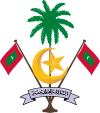Koimala
This article needs additional citations for verification. (January 2024) |
| Koimala | |
|---|---|
| Koimala Kalo | |
| |
| Father | King Siri Bovana Aananda |
Koimala Siri Mahaabarana Mahaa Radun (
According to the Isdhoo Loamaafaanu, he unified the Maldives from Minicoy (now a part of India) to Addu in the south under his rule. Local folklores claim that he was the first Muslim ruler, however it is his successor, Dhovemi of the Maldives, who converted to Islam in 1153.
Legend
Some versions of his legend claim that it refers to the first ruler of the Maldives after the
However, ascribing the legend to the first Islamic ruler does not explain who built the large
According to
A different account claims Koimala to be a
After the settlement in Malé, two vessels were dispatched to bring more people of his race to populate Malé. It was not in the tradition for the Giraavaru, and perhaps other aboriginal people of the Maldives, to marry outside their community.
Although he might have been the first king of the whole of Maldives, the story of a prince might instead be a corruption of the stories of King Soorudasaruna-Adeettiya and King Balaadeettiya, both exiled princes from the
Koimala's kingdom was referred to as Malikaddu dhemedhu- or 'all that lies between the
- Malikatholhu (now Minicoy islandbelonging to India)
- Thiladunmathi (Northern and southern parts of Thiladhunmathi Atoll)
- Miladunmaduva (Northern and southern parts of Miladhunmadulhu Atoll)
- Maalhosmaduva (North and South Maalhosmadulhu Atolls)
- Faadu Bur (Faadhippolhu)
- Mahal Atholhu (The Male' Atolls)
- Ari adhe Atholhu (Ari Atoll)
- Felide Atholhu (Felide Atoll)
- Mulakatholhu (Mulaku Atoll)
- Nilande Atholhu (North and South Nilande Atolls)
- Kolhumaduva (Kolhumadulu)
- Sathudhuvumati (Haddhunmathi Atoll)
- Suvadinmathi (Huvadhu Atoll)
- Addumulah (Atolls)
It is not clear where exactly Ihavandhippulhu Atoll,
Koimala was succeeded by his nephew Dhovemi Kalaminja in 1141.
References
- ISBN 84-7254-801-5
- ^ H.A. Maniku & G.D. Wijayawardhana, Isdhoo Loamaafaanu

